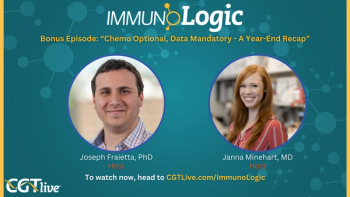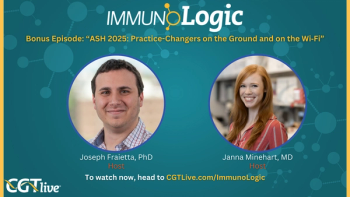
Using Programmable Genomic Integration to Make Edits Big and Small
John Finn, PhD, the chief scientific officer of Tome Biosciences, discussed the company’s pipeline for its new technology.
This is the second part of an interview with John Finn, PhD. For the first part,
Tome Biosciences is currently engaged in development of a unique programmable genomic integration (PGI) technology that it seeks to apply in various contexts, including both ex vivo cell therapy and in vivo gene therapy. The company presented some of its preclinical work regarding its platform at
In an interview with CGTLive® held shortly after the close of the conference, John Finn, PhD, the chief scientific officer of Tome Biosciences, spoke about the key implications of the data and the challenges the company has overcome so far. He also spoke about Tome's pipeline and the importance of tackling both common as well as rare diseases.
CGTLive: How would you summarize the implications of the data Tome presented at ASGCT this year?
John Finn, PhD: I think the key take home message is that this concept that we call PGI I think will be the foundation of a number of different classes of medicine moving forward. I think the work that we're doing with induced pluripotent stem cells (iPSCs) is really going to unleash the cell engineering field because now we can efficiently engineer the cell that makes all the other cells in ways we've never been able to with a speed we've never been able to. I'm very excited, actually, to see how this technology gets deployed, both at Tome and actually beyond.
For integrative gene therapies, we're talking about cures here, and really I can't underestimate that. One of the things that we talk about here at Tome is that because we can now put a functional copy in the right location that edit—not only will it stay under its own regulation and [can be] 1 product, regardless of what the mutation is—that edit will grow with the patient. We are trying to manifest a world, basically, where a child is born, they have a diagnosis, and we can give them a treatment where they'll never even know they were sick in the first place because we put the right gene in the right location and it grows with them. That's something that I'm very excited about. We are working as fast as we can right now, actually, to move this technology from monkeys into humans, but I really think this is just the start.
One other thing that that we showed actually yesterday was L-PGI. When I'm talking about PGI, that's a concept. One of the things we also did is we unveiled 2 different tools in the Tome's toolbox that can help enable that idea, and one of them is L-PGI, where the L stands for ligase. Essentially, this is a new method where we actually presynthesize the piece of DNA that we want, and we use a Cas9-targeted ligase to put that exactly where we want it to. Even though this is early days, it seems like it's a more efficient and more accurate method than other methods. Now, this is really good for single bases up to small hundreds of bases. If you need exon replacement, this might be good. If there's indications where you don't need a whole new copy of a gene, like small edits or exons, this is something that would work there.
I-PGI, where the I stands for integrase-mediated PGI—this is the workhorse. This is what I've been talking about where we can put large pieces of code. One of the nice things is that we can use L-PGI actually to enable I-PGI because the whole inventive step here with I-PGI is that we use a Cas9 with a writing enzyme, like an RT or a ligase, where we first write an integrase-landing site. This is what we call the beacon. Now we've engineered integrases that have high activity and specificity, where the integrase now puts that large piece of code at that target site. With these 2 tools in our toolbox now, essentially we can do anywhere from 1 base up to—well, we've shown we can do over 30,000—I don't think there's really an upper limit. As long as you can get that DNA, the integrase does not care how big the DNA is.
Have there been any major challenges in this work so far?
One of the early challenges that we faced at Tome was moving our technology from cycling cells in a dish, HEK 293s, into nondividing primary human hepatocytes. That was much harder than we thought, and so we had to do a lot of engineering of every component. That was absolutely a challenge that we've overcome. When I think about about future challenges I think we, like everyone else, will always be limited by the cells you can deliver to. I think this has been a holy grail of the entire field. I personally have done a lot of work with novel delivery systems. I think this is something the field has to solve. I think it's a hard problem, but I do think this is a solvable problem. But for every cell type and every tissue type where delivery is unlocked, there will be indications. We can't do everything at once, as I said we're starting with the liver because I think we can really derisk our core technology without taking a lot of delivery risk. But obviously we are interested in moving beyond as well.
Is there anything else you want to share?
I think one of the things that we also did last week is not just unveil where we are with our data and the progress we've made—we also unveiled our pipeline. I think one of the nice things about our pipeline is that I do think we are pretty differentiated. As I mentioned, for in vivo we are starting with phenylketonuria. It's a very severe disease with unmet need. But one of the things I think people will notice in our pipeline is that we're not just going after rare diseases. We're talking about cardiovascular disease, hemochromatosis, etc. I think this technology will help us not only help with rare monogenic diseases, but this will also help move gene therapy and cell therapy to larger populations. This is also true, of course, of our cell therapy, where we're actually moving into the autoimmune population, where we are essentially building a pipeline in a cell. This is the cell that's been custom made for that population.
So I do think we have very exciting work happening with the platform—it's been a lot of work—but I also think we're getting a lot of attention for our pipeline because it doesn't matter how good your platform is if you're not turning it into medicines that will have an impact. I'm proud to say, I think our pipeline will have a large impact across both rare and more common indications.
This transcript has been edited for clarity.
REFERENCES
1. Tome Biosciences presented data on its programmable genomic integration technologies at ASGCT. News release. Tome Biosciences, Inc. May 10, 2024. Accessed July 12, 2024. https://tome.bio/news/tome-biosciences-presented-data-on-its-programmable-genomic-integration-technologies-at-asgct/
Newsletter
Stay at the forefront of cutting-edge science with CGT—your direct line to expert insights, breakthrough data, and real-time coverage of the latest advancements in cell and gene therapy.





































